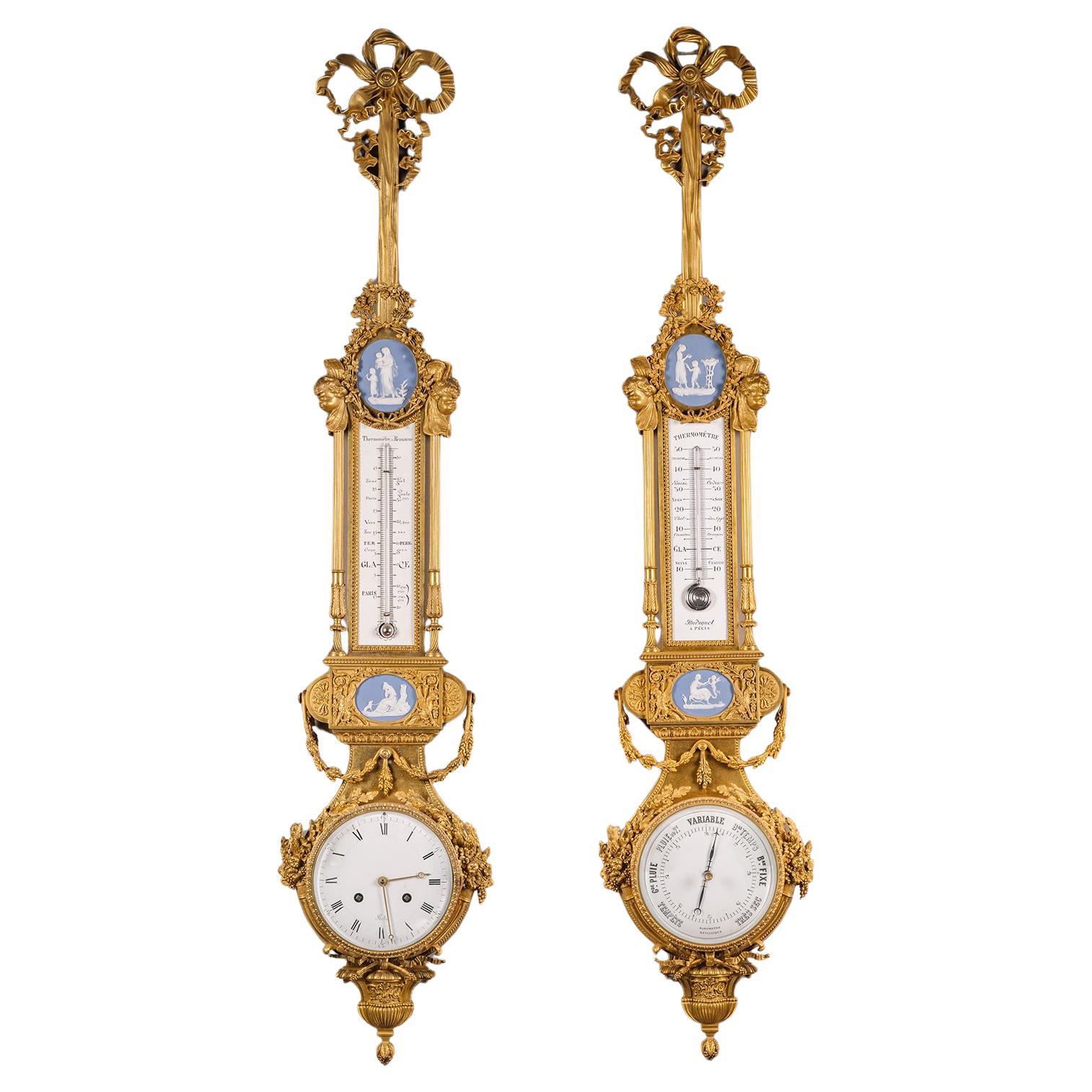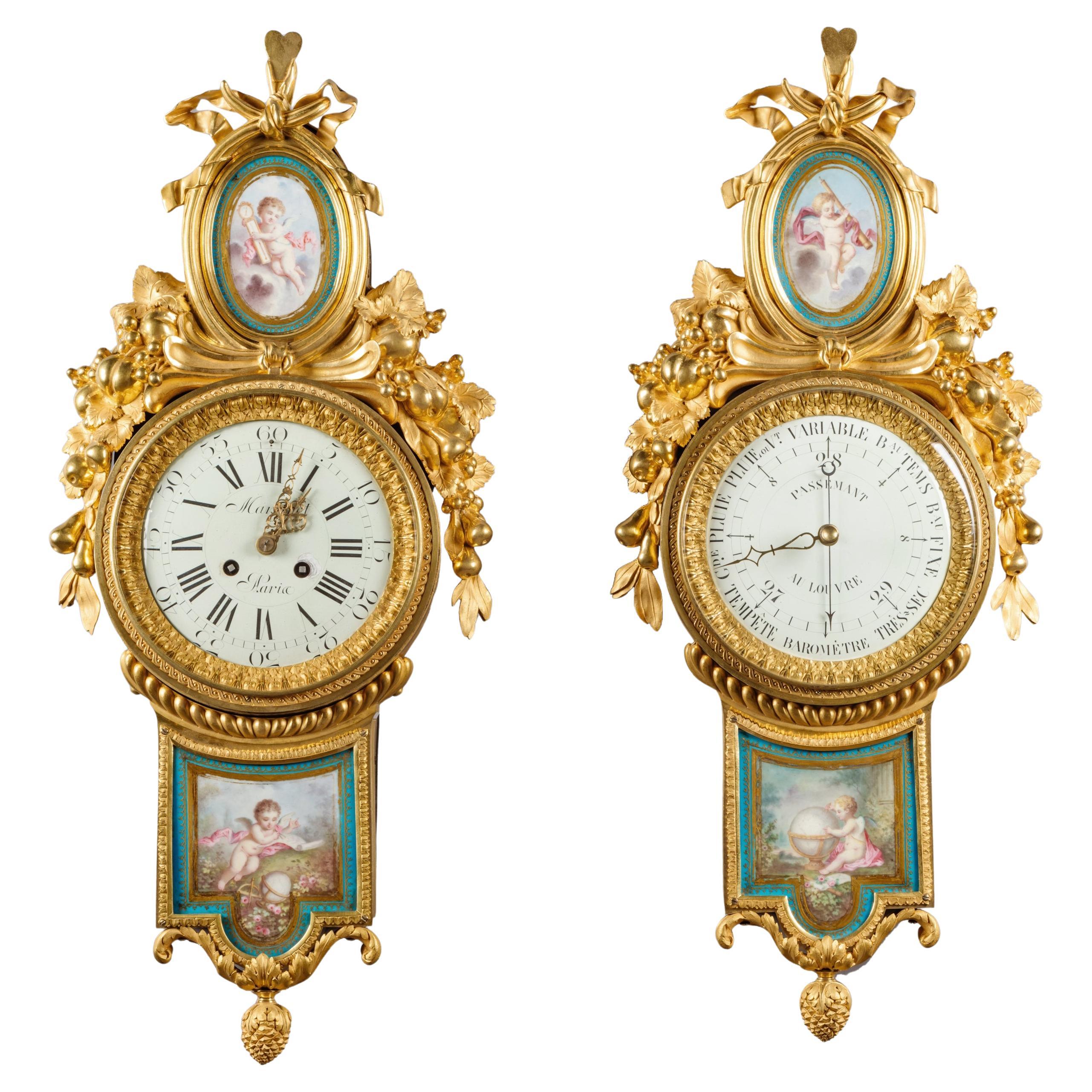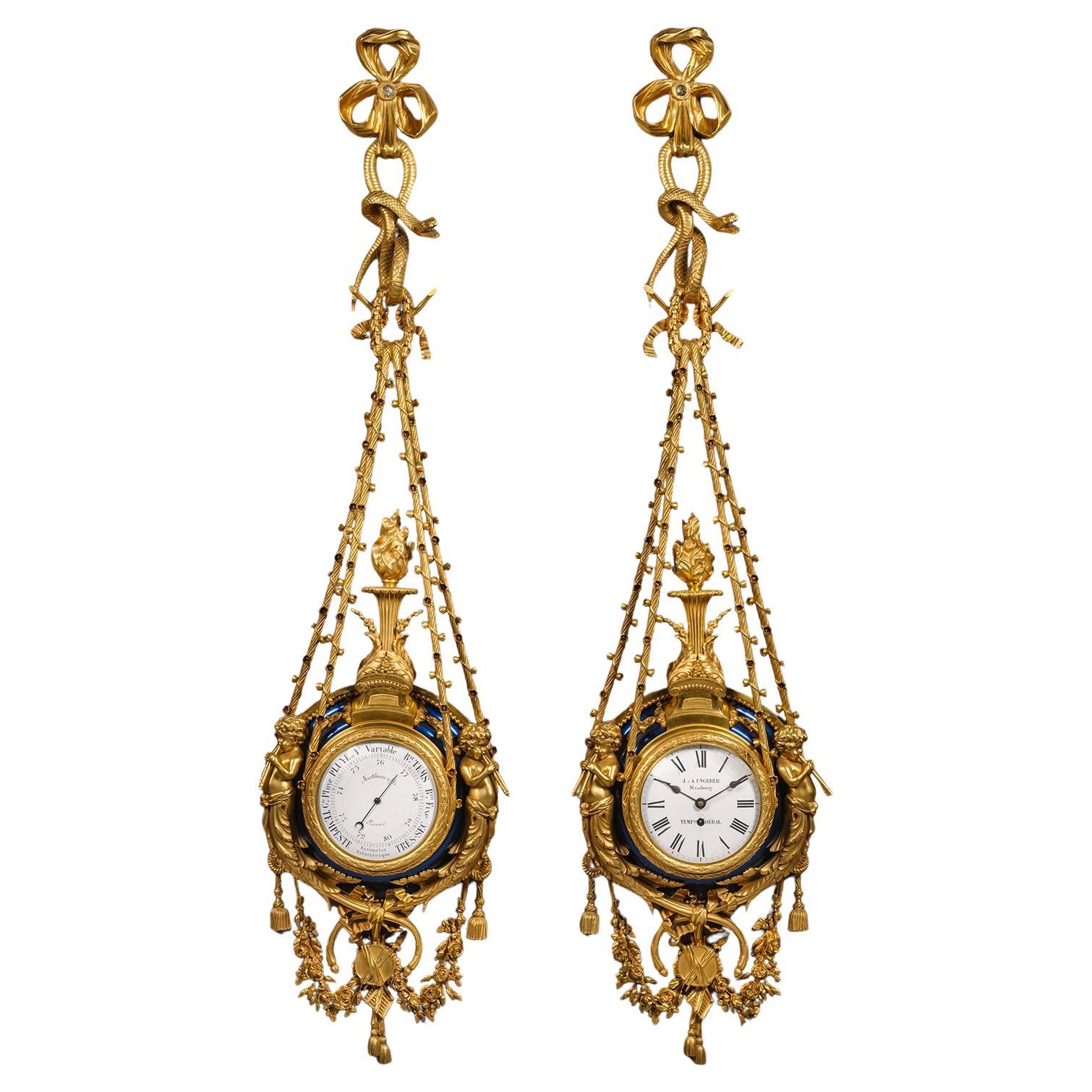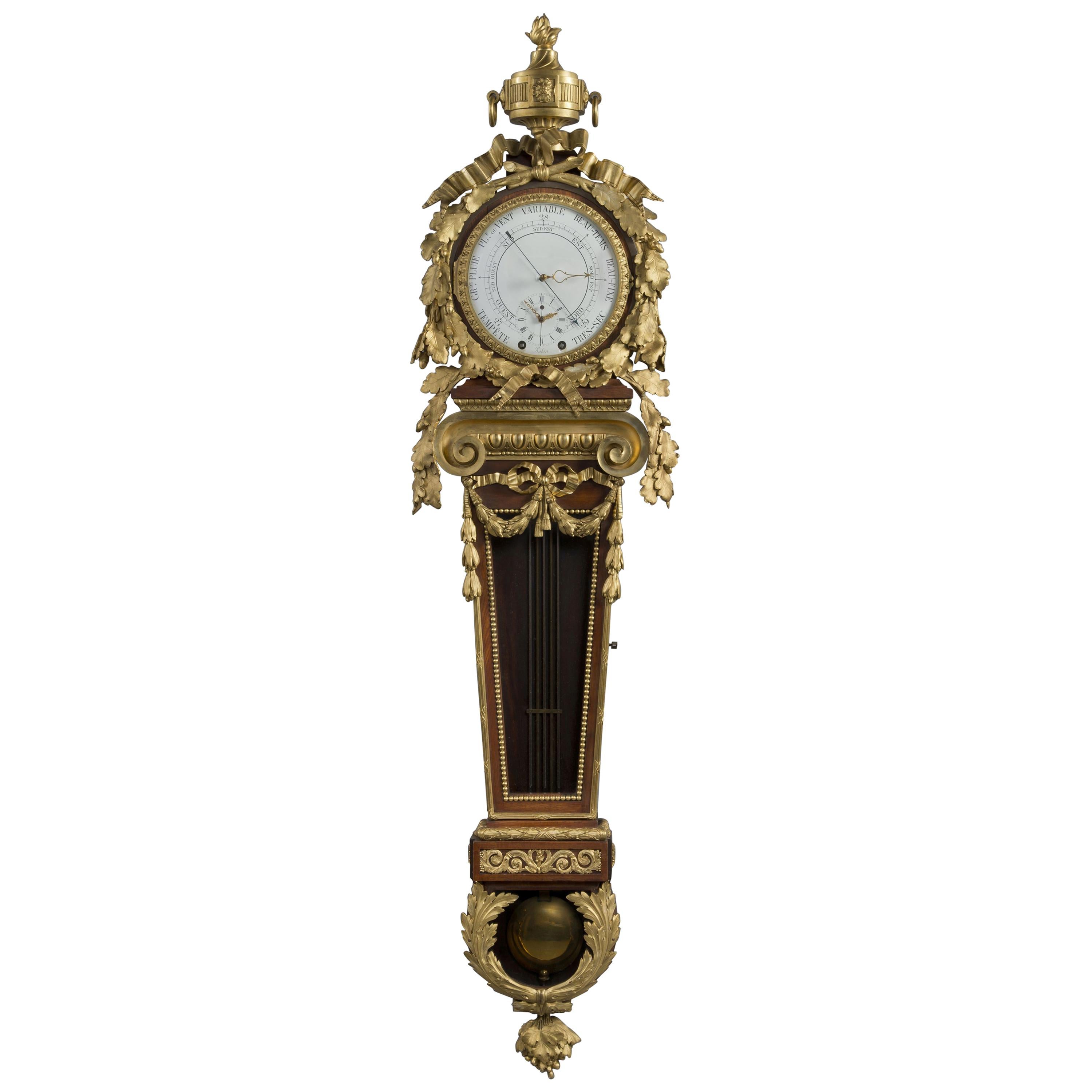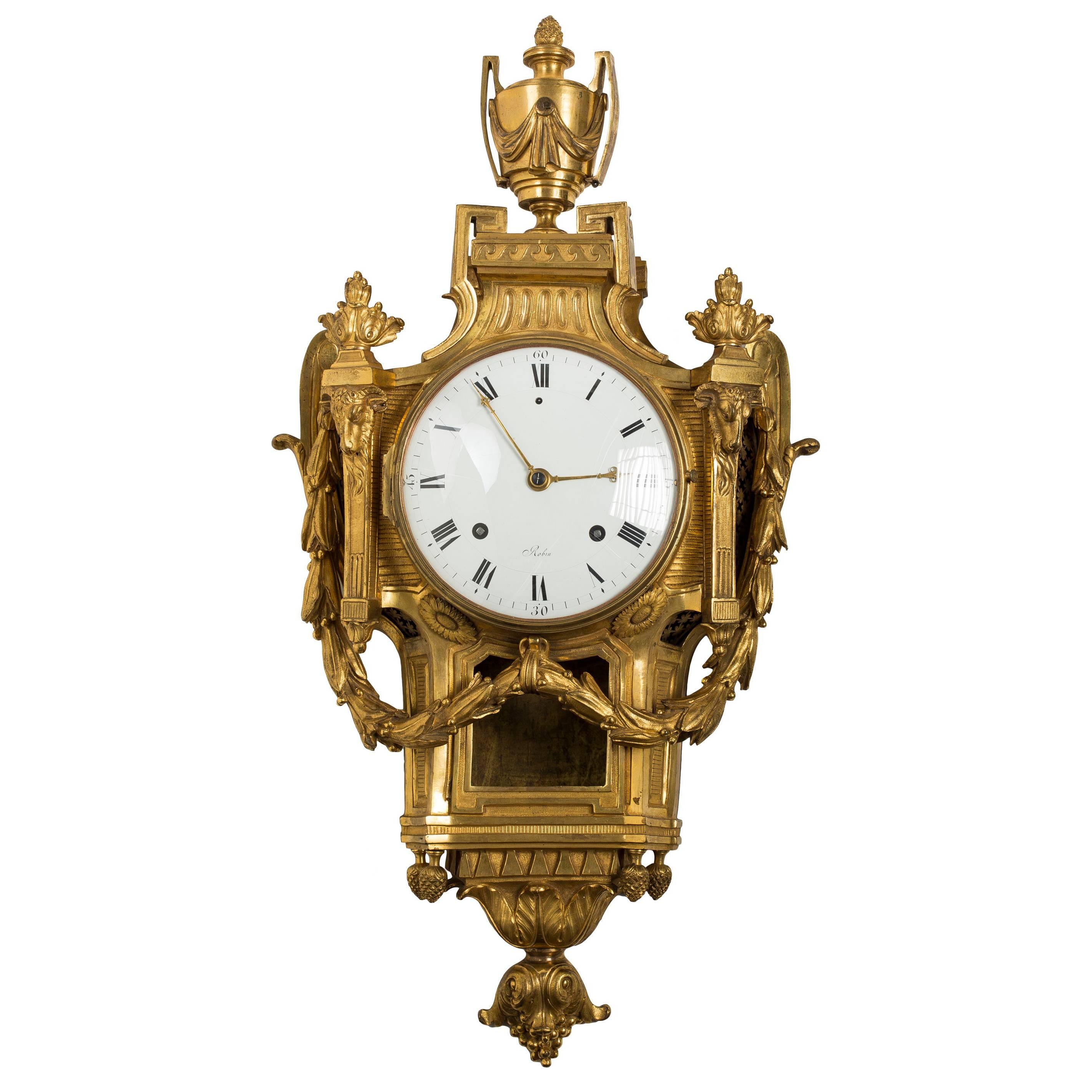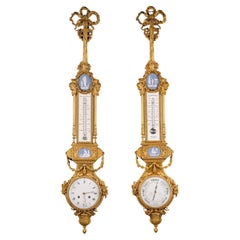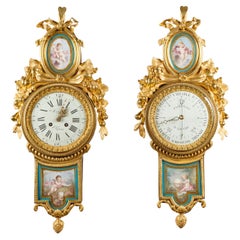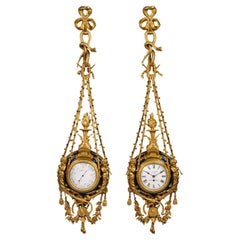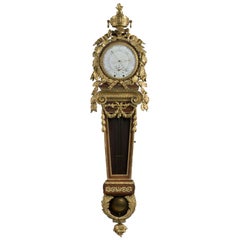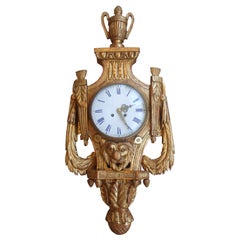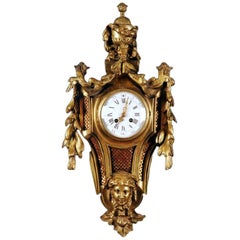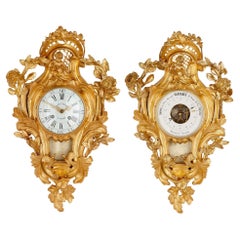Articoli simili a A Louis XVI Style Cartel Clock and Companion Barometer
Vuoi altre immagini o video?
Richiedi altre immagini o video al venditore
1 di 13
A Louis XVI Style Cartel Clock and Companion Barometer
Informazioni sull’articolo
A Louis XVI Style Gilt-Bronze and Jasperware Mounted Cartel Clock and Companion Barometer, After the Model Attributed to Pierre Gouthière.
The clock and barometer each surmounted by accompanying thermometers, jasperware plaques and ribbon tied finials. The gilt-bronze cases embellished with garlands of roses, cornucopia, fruiting vines and oak leaves in reference to the four seasons. Flanking the upper Jasperware plaque - two heads with delicate wings personifying the wind.
The clock with white enamelled dial, hours marked in Roman numerals and seconds in divisions of five in Arabic numerals. The eight-day twin-train movement with anchor escapement striking half and full hours on a bell, stamped with the number '80'. The companion aneroid barometer with conforming white enamel dial indicating barometric range TEMPETE, Gx Pluie, Pluie Ou VARIABLE, Beau Temps, Beau Fixe, TRES SEC, (Stormy, Rainy Variable, Nice Weather, Fair Weather and Very Dry). The thermometers marked with the Réaumur scale. The thermometer set above the barometer, consists of an alcohol filled glass thermometer capillary tube with a scale running from 25 degrees below zero to 35 degrees above, following the Réaumur scale.
The unusually cold temperatures attained in Paris during the winter of 1785 are indicated on the two thermometers and explains the extremes of the scale used.
The present cartel clock and matching barometer are based on a model attributed to the bronzier Pierre-Joseph-Désiré Gouthière (d. 1813), originally from the Château de Saint-Cloud and now part of the permanent collection at the Musée du Louvre (OA 5493 and OA 5494).
Stamped 'P G' to the back of the bronze in the cast.
French, Circa 1880.
In the second half of the 19th century, furniture and works of art, once the preserve of the aristocracy and often literally made for royalty, were transferred, often through war and revolution, to state museum collections, many via pioneering private collectors. Before this time, there were very few museums.
The examples in the Louvre (shown in an old black and white photograph), attributed to the bronze maker Pierre Gouthière and the horloger Carcany, were made circa 1785 for a member of Louis XVI’s court, very possibly for Queen Marie Antoinette herself. By the mid-19th century, they were at the Château de Saint-Cloud, perhaps in the Salon of Empress Eugenie. With the fall of the Second Empire, they were transferred to the Musée du Louvre, where they were properly documented, photographed, published, and exhibited.
The fashion for the Ancien Régime and ‘tous les Louis’ drove a new breed of collectors, such as Sir Richard Wallace and Henry Clay Frick. Public exhibitions of royal furniture and works of art gave contemporary makers the opportunity to examine these masterpieces up close for the first time. Makers competed to produce the most magnificent replicas, and versions of these clocks and barometers were exactingly made during the late 19th century.
Literature:
C. Dreyfus, Musée du Louvre, pl. LV, no. 392 & 393, for the illustration of the 18th century examples attributed to Gouthière (the 18th century examples attributed to Gouthière).
C. Dreyfus, Mobilier et Objets d’Art du XVIIe du XVIIIe Siècle, Musée du Louvre, Département des objets d'art, Paris, 1913, No. 358 ‘Cartel et thermomère’ and no. 359 ‘Barometère’, p. 65 (the 18th century examples attributed to Gouthière).
D. Alcouffe, Gilt Bronzes in the Louvre, Paris, 2014, p. 213. (the 18th century examples attributed to Gouthière).
C. Mestdagh, L'ameublement d'art français: 1850-1900, Paris, 2010, fig. 258., p. 221(for a pair by Emmanuel-Alfred (dit Alfred II) Beurdeley (1847-1919)).
- Simile a:Pierre Gouthiere (Designer)
- Dimensioni:Altezza: 117 cm (46,07 in)Larghezza: 23 cm (9,06 in)Profondità: 12 cm (4,73 in)
- Stile:Luigi XVI (Nello stile di)
- Materiali e tecniche:
- Luogo di origine:
- Periodo:
- Data di produzione:Circa 1880
- Condizioni:Usura compatibile con l’età e l’utilizzo.
- Località del venditore:Brighton, GB
- Numero di riferimento:Venditore: B781201stDibs: LU1028045340822
Informazioni sul venditore
5,0
Venditore riconosciuto
Questi venditori prestigiosi sono leader del settore e rappresentano il massimo in termini di qualità e design.
Venditore Platino
Venditori Premium con valutazione 4.7+ e tempi di risposta entro 24 ore
Fondazione nel 1964
Venditore 1stDibs dal 2014
58 vendite su 1stDibs
Tempo di risposta standard: 1 ora
Associazioni
The British Antique Dealers' AssociationLAPADA - The Association of Arts & Antiques Dealers
- SpedizioneRecupero del preventivo…Spedizione da: Brighton, Regno Unito
- Politica di reso
Alcune parti di questa pagina sono state tradotte automaticamente. 1stDibs non può garantire che le traduzioni siano corrette. L’inglese è la lingua predefinita del sito.
Garanzia di autenticità
Nell’improbabile caso in cui si verifichi un problema con l’autenticità di un articolo, contattaci entro un anno per ottenere un rimborso completo. DettagliGaranzia di rimborso
Se il tuo articolo non corrisponde alla descrizione, è danneggiato durante il trasporto o non arriva, contattaci entro 7 giorni per un rimborso completo. DettagliAnnullamento entro 24 ore
Hai un periodo di tolleranza di 24 ore per annullare il tuo acquisto, senza necessità di fornire spiegazioni.Venditori professionali selezionati
I nostri venditori di livello internazionale devono aderire a rigorosi standard di servizio e qualità, garantendo l’integrità delle inserzioni.Garanzia miglior prezzo
Se scopri che un venditore ha pubblicato altrove lo stesso articolo a un prezzo più basso, applicheremo lo stesso prezzo.Consegna globale affidabile
La nostra rete di vettori leader del settore offre opzioni di spedizione specializzate in tutto il mondo, inclusa la consegna personalizzata.Altro da questo venditore
Mostra tuttoOrologio a cartello e barometro in stile Luigi XVI di Pierre Gouthière
Di Maison Millet
Orologio a cartello in bronzo dorato e porcellana di Wedgwood in stile Luigi XVI e barometro di accompagnamento, di Maison Millet, Parigi, secondo il modello attribuito a Pierre Gout...
Categoria
Di antiquariato/d’epoca, XIX secolo, Francese, Luigi XVI, Orologi a parete
Materiali
Smalto, Similoro
Orologio a cartello e barometro in porcellana di Sèvres in stile Luigi XVI
Pregevole orologio a cartello montato in bronzo dorato e porcellana di Sèvres e barometro aneroide en suite, secondo i modelli di Martinout e Passemant.
L'orologio ha un movimento ...
Categoria
Di antiquariato/d’epoca, XIX secolo, Francese, Luigi XVI, Orologi a parete
Materiali
Bronzo, Smalto
Orologio a cartello e barometro in stile Luigi XVI in bronzo dorato e smalto blu
Di Maison Mottheau et Fils
Orologio a cartello e barometro in bronzo dorato e smalto blu in stile Luigi XVI, Maison Mottheau & Fils, Parigi.
Questo eccezionale orologio a cartello e barometro aneroide mostra ...
Categoria
Di antiquariato/d’epoca, XIX secolo, Francese, Luigi XVI, Orologi a parete
Materiali
Bronzo, Smalto
Orologio a cartello e barometro in mogano in stile Luigi XVI, dopo Carlin, circa 1870
Di Martin Carlin
Pregevole orologio a cartello e barometro in mogano montato in stile Louis XVI in bronzo dorato, secondo il modello di Martin Carlin.
Francese, circa 1870.
Il quadrante è firm...
Categoria
Di antiquariato/d’epoca, Fine XIX secolo, Francese, Luigi XVI, Orologi a...
Materiali
Bronzo
Orologio e barometro in legno dorato intagliato di grandi dimensioni e in stile Luigi XVI
Un grande e importante orologio e barometro in legno dorato intagliato in stile Luigi XVI.
Ciascuno con quadranti circolari in smalto, l'orologio con numeri romani e arabi e lance...
Categoria
Di antiquariato/d’epoca, XIX secolo, Francese, Luigi XVI, Orologi a parete
Materiali
Legno dorato
Orologio di cartello in stile Luigi XVI in bronzo dorato, di Beurdeley
Di Alfred Emmanuel Louis Beurdeley
Un raffinato orologio di cartello in stile Luigi XVI in bronzo dorato, di Beurdeley.
Firmato 'A Beurdeley Fils à Paris'.
Sormontata da un globo legato da un nastro, la cassa in b...
Categoria
Di antiquariato/d’epoca, XIX secolo, Francese, Luigi XVI, Orologi a parete
Materiali
Bronzo
Ti potrebbe interessare anche
Orologio Cartel Luigi XVI
Eccezionale orologio Cartel Luigi XVI intagliato e rifinito in legno dorato, sormontato da un'urna a doppio manico su una piattaforma intagliata sopra un quadrante dipinto di bianco ...
Categoria
Di antiquariato/d’epoca, XVIII secolo, Francese, Luigi XVI, Orologi a pa...
Materiali
Legno
12.000 USD
Orologio di cartello Luigi XVI Ormolu
Il quadrante circolare in smalto bianco smaltato con capitoli romani e arabi, all'interno di una cassa traforata con scie di alloro fruttifere legate a nastro, ogni lato con una lese...
Categoria
Di antiquariato/d’epoca, Fine XVIII secolo, Francese, Luigi XVI, Orologi...
Materiali
Bronzo
14.000 USD Prezzo promozionale
20% in meno
Orologio a cartello in stile Luigi XVI con ormolu
Con un quadrante circolare in smalto bianco, sormontato da volute e terminante con un volto di donna.
Movimento Morbiere
Categoria
Di antiquariato/d’epoca, XIX secolo, Francese, Orologi
Orologio a cartelli e barometro in bronzo dorato in stile rococò
Per l'uso elaborato di volute a C, figure di putti, foglie d'acanto e fiori stilizzati, questo orologio e questo barometro sono chiaramente in stile rococò. Il rococò divenne di moda...
Categoria
Di antiquariato/d’epoca, XIX secolo, Francese, Rococò, Orologi da camino
Materiali
Smalto, Similoro, Bronzo
24.939 USD / set
Antique French, orologio a cartello in bronzo dorato in stile Luigi XVI
Antique French, orologio a cartello in bronzo dorato in stile Luigi XVI
Francese, fine del XIX secolo
Altezza 63cm, larghezza 28cm, profondità 10cm
Questo elegante orologio a cartel...
Categoria
Di antiquariato/d’epoca, XIX secolo, Francese, Luigi XVI, Orologi
Materiali
Similoro
Orologio da parete in spelta del XIX secolo in stile Luigi XVI
Orologio da parete a cartello in stile Luigi XVI, realizzato in Francia intorno al 1880-1890. La cassa è realizzata in fusione di spelta (lega metallica) e dotata di quattro vetri a ...
Categoria
Di antiquariato/d’epoca, Anni 1880, Francese, Luigi XVI, Orologi a parete
Materiali
Ottone, Smalto, Zinco commerciale
